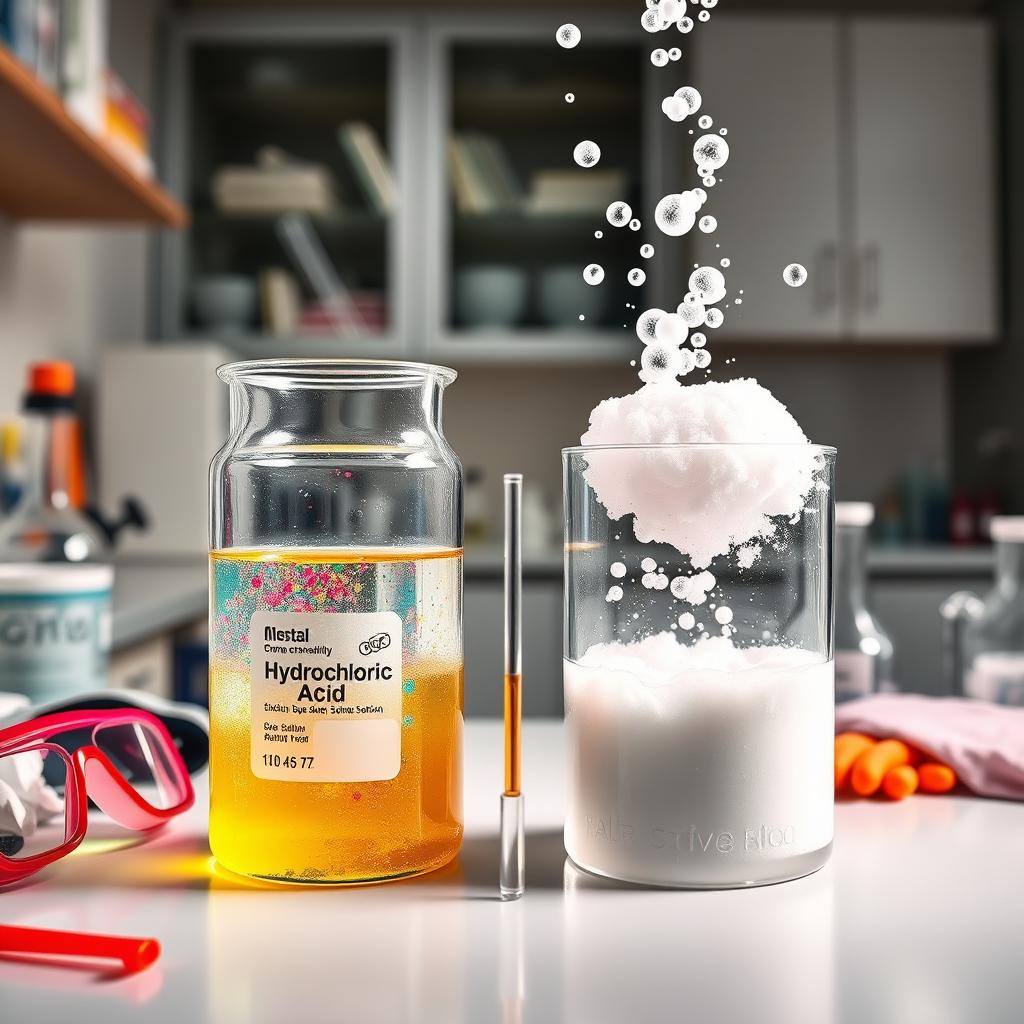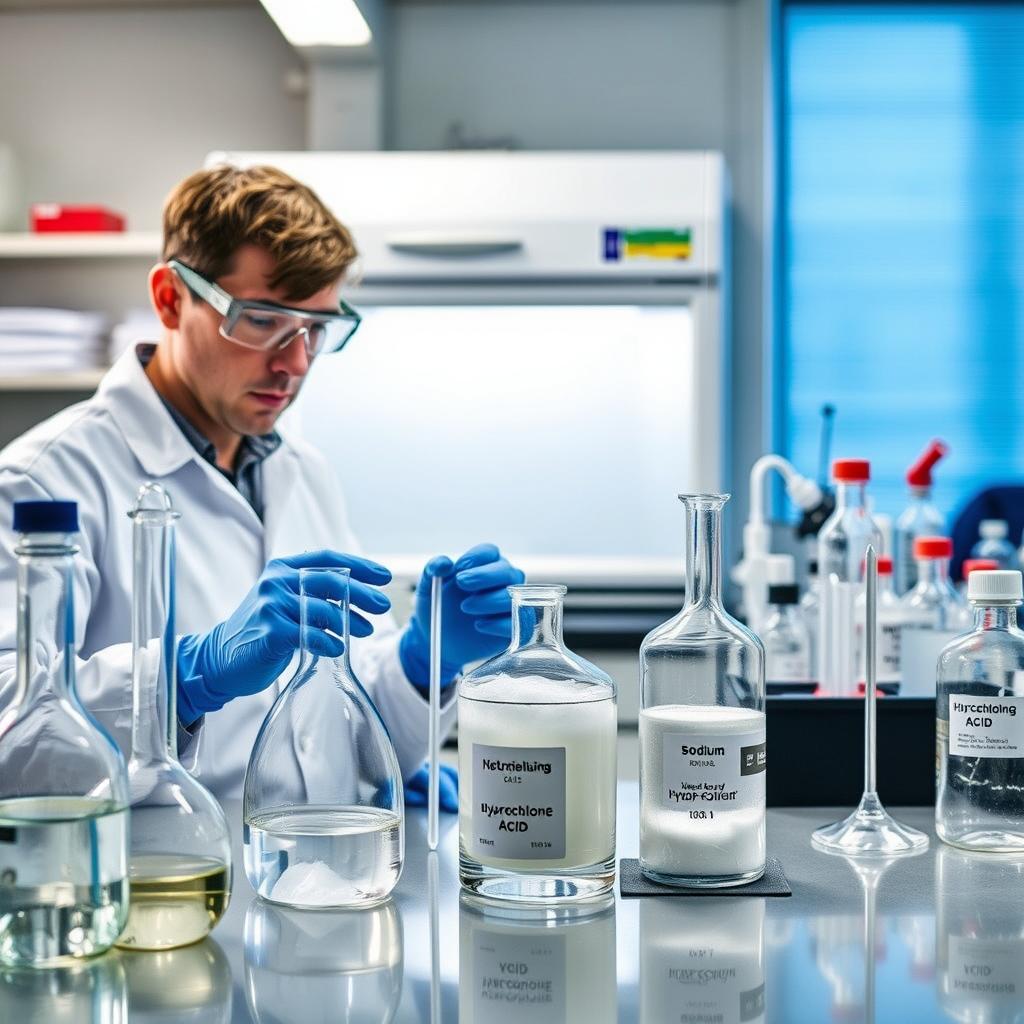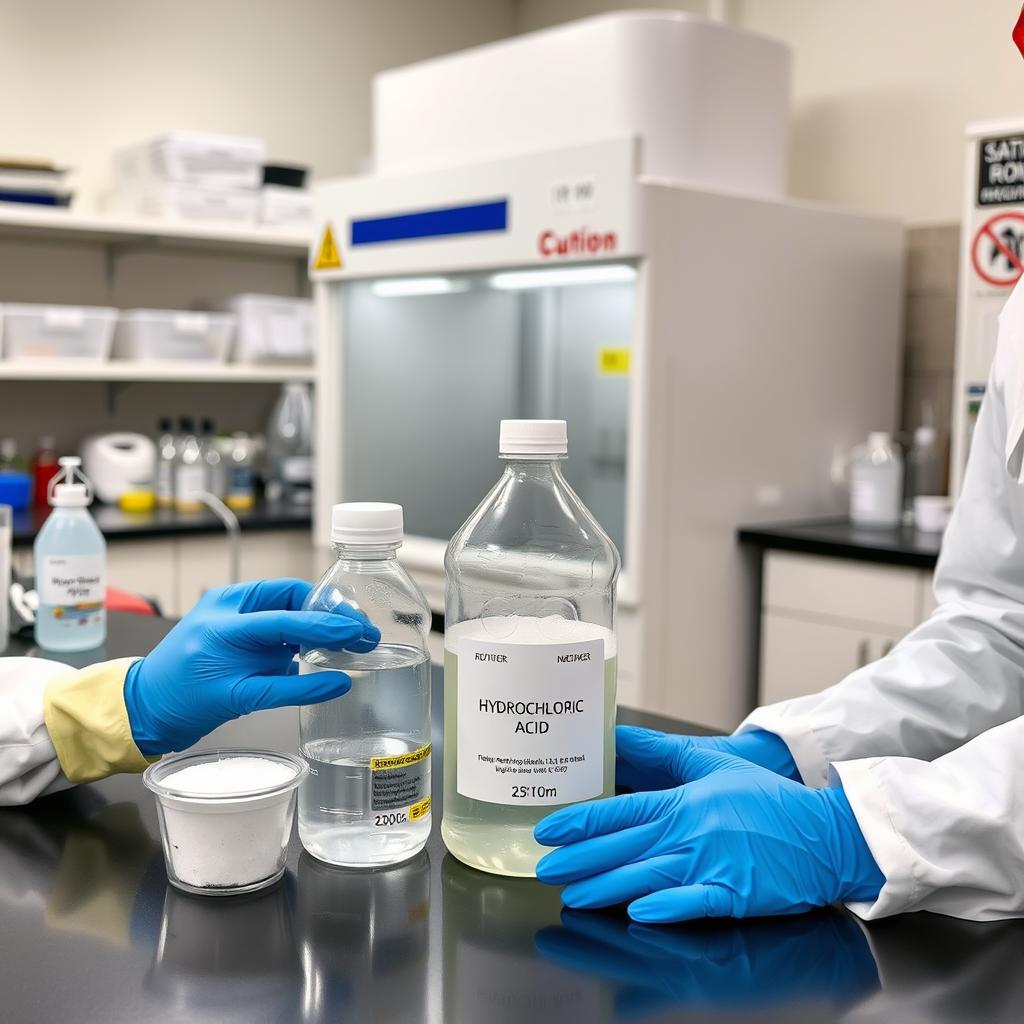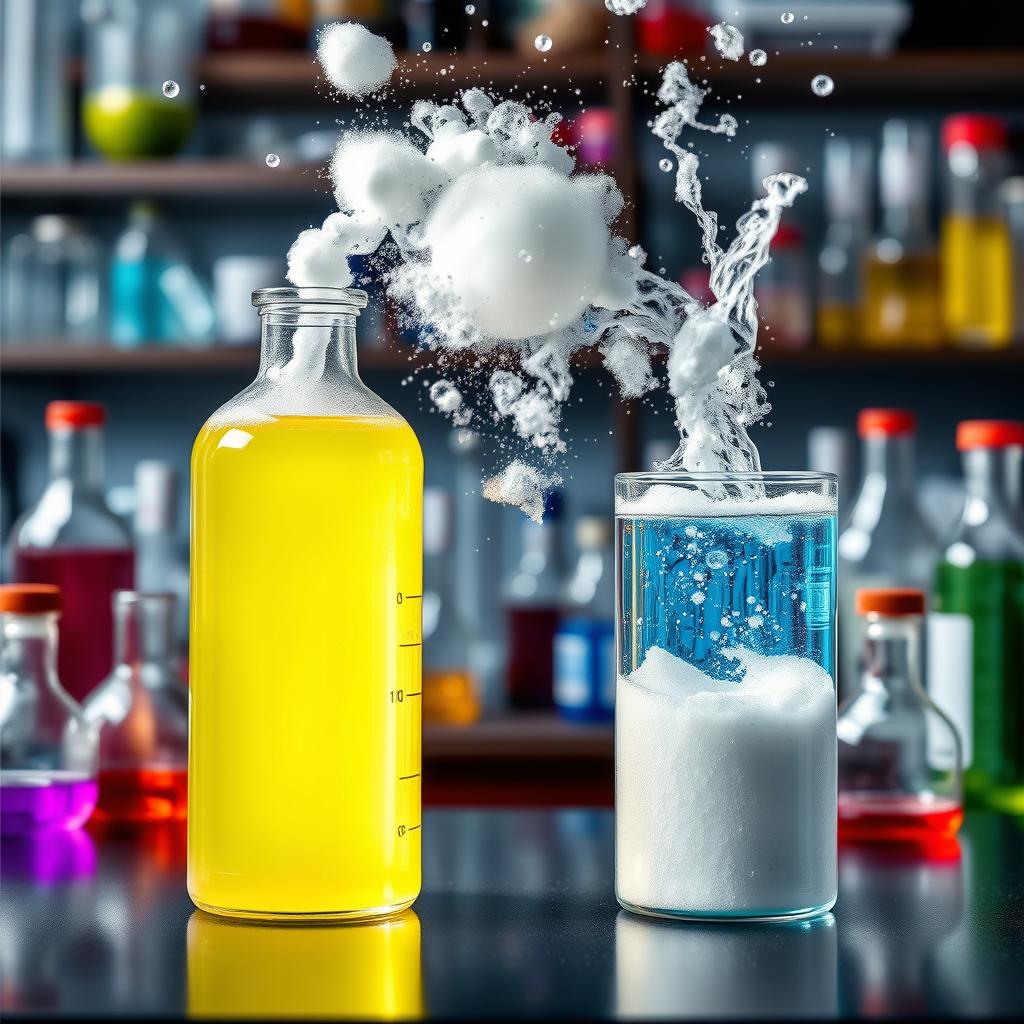Can hydrochloric acid be safely neutralized? Yes, and there are effective methods to do so. To neutralize it, we use a base to react with the acid. This reaction forms water and a salt. It’s important to know how to neutralize hydrochloric acid. This knowledge helps prevent accidents and protects the environment. Understanding the chemical properties of hydrochloric acid and acid-base reactions is key.
Click to use Silverigroup personal shopper services
Neutralizing hydrochloric acid needs careful handling and safety protocols. We aim to learn how to do it safely and effectively. The right materials and procedures are essential. To neutralize hydrochloric acid, using a base is crucial. This base reacts with the acid, creating water and a salt.
Key Takeaways:
- Hydrochloric acid is a strong acid that requires careful handling and neutralization.
- Neutralizing hydrochloric acid involves using a base to react with the acid, forming water and a salt.
- Understanding the chemical properties of hydrochloric acid is crucial for safe and effective neutralization.
- Proper safety protocols must be followed when handling hydrochloric acid.
- Learning how to neutralize hydrochloric acid is essential for preventing accidents and environmental damage.
- Using the right materials and following proper procedures is key to safely neutralize hydrochloric acid.
Understanding the Dangers of Hydrochloric Acid
Hydrochloric acid is very corrosive. It can burn skin and eyes badly. It also releases harmful fumes when mixed with other substances. Knowing how dangerous hydrochloric acid is is key to handling it safely. The chemical reaction of acid neutralization mixes hydrochloric acid with a base like sodium hydroxide. This creates water and sodium chloride. This process is vital for safety and preventing accidents.
Click to buy citric acid from Silvairgroup
Exposure to hydrochloric acid can lead to serious health issues. These include:
- Respiratory problems
- Skin and eye irritation
- Severe burns
To avoid these risks, it’s crucial to follow safety guidelines when working with hydrochloric acid. The role of acid neutralization in preventing accidents cannot be overstated. It ensures a safe work environment. Understanding the dangers of hydrochloric acid and the role of chemical reaction in neutralizing it is vital. This knowledge helps protect everyone from the risks of this substance. It’s essential for anyone dealing with hydrochloric acid, whether in a professional or home setting.
| Substance | Chemical Reaction | Result |
|---|---|---|
| Hydrochloric Acid | Acid Neutralization | Water and Sodium Chloride |

Essential Safety Equipment and Preparation
When working with hydrochloric acid, it’s vital to follow safety precautions to avoid risks. Wear gloves, safety glasses, a face shield, and a lab coat. Make sure the area is well-ventilated and use a fume hood if you have one. Before starting, read the safety data sheet (SDS) for hydrochloric acid. It has important info on handling and emergency steps. Knowing how to use safety equipment is also crucial. Some key safety equipment includes:
- Spill response kit
- Fire extinguisher rated for chemical fires
- First aid kit
Click to buy frozen a grade beluga fish from Silverigroup
By following these safety precautions and using the right protective equipment, you can lower risks. Regular training and drills are also important to be ready for emergencies. Remember, safety precautions and protective equipment are not just for handling hydrochloric acid. They keep your work area safe. By focusing on safety, you protect yourself and others from dangers.
| Equipment | Description |
|---|---|
| Gloves | Protect hands from chemical splashes |
| Safety Glasses | Protect eyes from chemical splashes |
| Face Shield | Protect face from chemical splashes |
Steps to Neutralize Hydrochloric Acid
Neutralizing hydrochloric acid is a key task in labs. It needs careful steps and following rules to keep everyone safe. First, pick a good neutralizing agent like sodium hydroxide, sodium carbonate, or calcium hydroxide.
Selecting the Appropriate Neutralizing Agent
The right agent depends on the acid’s strength, what you want to achieve, and safety. Sodium hydroxide is often used because it’s very basic. But, make sure to use the right amount to avoid problems.
Calculating Required Quantities
To figure out how much agent you need, use this formula:
| Neutralizing Agent | Formula |
|---|---|
| Sodium Hydroxide (NaOH) | NaOH (g) = HCl (ml) x concentration (M) x 40 |
| Sodium Carbonate (Na2CO3) | Na2CO3 (g) = HCl (ml) x concentration (M) x 53 |
When mixing, add the agent slowly while stirring. Do this in a well-ventilated area or under a fume hood. This keeps harmful fumes away. By following these steps, you can safely and effectively neutralize hydrochloric acid.

Emergency Response Procedures
In case of a hydrochloric acid spill, having a solid emergency plan is key. This plan should cover immediate actions, first aid, and when to call emergency services. A quick and right response can stop more damage and exposure, making chemical spill cleanup smoother. The first thing to do is to clear the area and stop the spill with absorbents. This stops the acid from spreading and lowers the chance of acid-base reaction with other things. Always wear protective gear like gloves and goggles when dealing with spills to avoid skin and eye harm.
Immediate Actions for Spills
- Evacuate the area immediately
- Contain the spill using absorbent materials
- Wear protective gear, including gloves and goggles
First Aid Measures
If skin or eyes get exposed, flushing with lots of water is crucial. If needed, get medical help. For skin, take off dirty clothes and wash with soap and water. For eyes, rinse with water for 15 minutes and get medical help right away.
When to Contact Emergency Services
Call emergency services if the spill is big, there’s a chance of environmental harm, or if someone is hurt. It’s also important to have a plan for getting rid of the spilled acid and cleanup materials. Follow proper chemical spill cleanup steps to avoid any acid-base reaction that could make things worse.
| Spill Size | Response |
|---|---|
| Small | Contain and clean up using absorbent materials |
| Large | Contact emergency services and follow their instructions |
Laboratory Best Practices for Acid Handling
Handling hydrochloric acid in a lab requires careful steps to avoid accidents. A detailed laboratory procedure is key to a safe and successful experiment. It’s important to follow safety precautions closely.
To keep the lab safe, follow these guidelines:
- Wear the right personal protective equipment (PPE), like gloves, goggles, and a lab coat
- Use fume hoods when working with substances that can evaporate quickly
- Make sure all equipment works well and is checked often
It’s also vital to have regular training on emergency plans. This includes knowing how to handle spills and accidents. Having a plan for evacuation and first aid is essential.

By sticking to these safety precautions and having a solid laboratory procedure, lab workers can reduce risks. This ensures a safe and successful experiment with hydrochloric acid.
| Best Practice | Description |
|---|---|
| Regular Training | Provide regular training on emergency response procedures and laboratory safety protocols |
| Equipment Inspection | Regularly inspect equipment to ensure it is in good working condition |
| PPE Use | Ensure all laboratory personnel wear appropriate PPE, including gloves, goggles, and a lab coat |
Environmental Considerations and Disposal Methods
When working with hydrochloric acid, we must think about its impact on the environment. The way it reacts with other substances can harm our planet if not managed right. It’s important to dispose of it properly and reduce waste.
Disposing of hydrochloric acid and its byproducts needs careful thought to avoid harming the environment. We should neutralize the acid first and use the right containers and places for disposal. Prevention is key in reducing the harm caused by hydrochloric acid. We should use safer alternatives and follow all local and national rules for disposal.
Proper Disposal Guidelines
- Neutralize the acid before disposal
- Use approved containers and facilities
- Follow local and national regulations
By following these steps and being proactive about the environment, we can lower the risks of hydrochloric acid. Acid neutralization is complex, but with the right steps, it can be done safely. This helps protect our planet for the future.
Environmental Impact Prevention
To avoid harming the environment, we need to know the risks of hydrochloric acid. We should understand the chemical reaction in acid neutralization and take steps to avoid accidents. Working together, we can lessen the environmental impact of hydrochloric acid. This makes our world safer and more sustainable for all.

Common Mistakes to Avoid When Neutralizing HCl
When working with acids, it’s key to follow the right steps to stay safe. Not wearing the right protective equipment, like gloves and goggles, can hurt you. Another big mistake is mixing errors. This can happen when you add the acid to the neutralizer instead of the other way around. This can lead to dangerous splashes and reactions. Always stick to the right procedures for acid handling.
- Not following established procedures for handling acids
- Not wearing appropriate protective equipment
- Mixing errors, such as adding the acid to the neutralizing agent instead of vice versa
Knowing these common mistakes helps you avoid them. This way, you can safely neutralize hydrochloric acid. Always pay close attention and follow the right steps to keep yourself and others safe.
| Mistake | Consequence |
|---|---|
| Not wearing protective equipment | Personal injury |
| Mixing errors | Violent reactions and splashing |
Documentation and Reporting Requirements
Handling hydrochloric acid requires careful documentation and reporting. These steps are key to preventing future accidents. They help improve safety by spotting areas for better protocols. During a chemical spill cleanup, quick action is vital. It helps reduce damage and risk. In an acid-base reaction, documenting the incident is crucial. This helps in making safety procedures better for the future.
Reporting rules differ by place. But, usually, you must tell local authorities and agencies about spills or releases. This is when the amount is over a certain limit. Important points for documentation and reporting are:
- Notify local authorities and agencies about spills or releases.
- Record the cause, response, and outcome of incidents.
- Improve safety procedures to avoid future incidents.
By focusing on documentation and reporting, we can handle chemical spill cleanup and acid-base reaction safely. This approach not only prevents accidents but also fosters a culture of safety and responsibility. Remember, accurate and timely documentation and reporting are key. They help prevent future incidents and ensure a safe work environment.
| Incident Type | Documentation Requirements | Reporting Requirements |
|---|---|---|
| Chemical Spill | Cause, response, and outcome | Notify local authorities and regulatory agencies |
| Acid-Base Reaction | Cause, response, and outcome | Notify local authorities and regulatory agencies |
Conclusion
To safely neutralize hydrochloric acid, you need to focus on safety, understand the chemical, and follow the right steps. This guide helps you neutralize hydrochloric acid well. It also keeps you and the environment safe. Knowing how to neutralize hydrochloric acid is crucial. It’s not just about following steps. It’s about keeping everyone safe. Always wear the right gear and measure carefully. This guide will help you handle chemicals better. It’s a key tool for working with hydrochloric acid. By following these rules, you help make the world safer and more sustainable.
FAQ: How to neutralize hydrochloric acid
What is hydrochloric acid and why is it important to neutralize it?
Hydrochloric acid (HCl) is a strong acid used in many industries and labs. It’s crucial to neutralize it to avoid accidents, harm to the environment, and health risks.
What are the chemical properties of hydrochloric acid?
Hydrochloric acid is very reactive and corrosive. It fully breaks down in water, creating hydrogen and chloride ions. It can release harmful fumes and cause severe burns if it touches skin or eyes.
What are the common sources of hydrochloric acid?
You can find hydrochloric acid in industrial settings, labs, and some cleaning products. Knowing where it comes from helps us understand the risks of exposure.
What personal protective equipment (PPE) is required when handling hydrochloric acid?
When working with hydrochloric acid, you need to wear protective gear. This includes gloves, safety glasses, a face shield, and a lab coat. Make sure the area is well-ventilated and use a fume hood if you have one.
What are the steps to neutralize hydrochloric acid?
To neutralize hydrochloric acid, first choose a suitable neutralizing agent. Then, calculate how much you need and mix it carefully. Common agents are sodium hydroxide, sodium carbonate, and calcium hydroxide.
What should you do in the event of a hydrochloric acid spill?
If there’s a spill, act fast. Evacuate the area and use absorbents to contain the spill. Use a neutralizing agent carefully. You might need to call for emergency help and provide first aid.
What are some common mistakes to avoid when neutralizing hydrochloric acid?
Avoid mixing errors, like adding acid to the wrong agent. Also, don’t skip safety steps like wearing PPE or following procedures. These mistakes can cause dangerous reactions and harm.
What are the documentation and reporting requirements for handling hydrochloric acid?
Keeping records and reporting incidents is key when working with hydrochloric acid. Document all spills and exposures. Reporting rules can vary, but accurate records help prevent future problems and improve safety.

